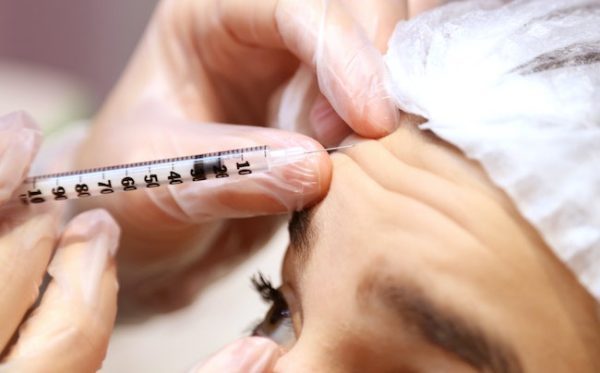
A common misconception about baby Botox is that it refers to Botox injections administered to someone in their 20s, but this is not the case. So what is baby Botox? Baby Botox, also called micro Botox, simply refers to smaller doses of Botox being injected.
If you have never had Botox and are concerned about looking like you have a frozen face, you might want to consider starting with baby Botox, as it will produce an extremely subtle, natural change.
In this post, we cover everything you need to know about baby Botox to help you to ask the right questions when looking for an aesthetic practitioner. If you prefer to speak to someone, you can contact us to arrange a no-obligation consultation at our Harley Street clinic in London.
But is baby Botox worth it? To understand why you might choose to have baby Botox instead of regular Botox, it is important to know how Botox works.
Botox is botulinum toxin type A, a neurotoxin that blocks nerve signals triggering muscle contraction, so limiting movement. The result is preventative, as your muscles aren’t causing your skin to crease while reducing the depth and visibility of current lines and wrinkles. In addition to treating lines and wrinkles and keeping your skin crease-free, Botox can slim the face.
Baby Botox is exactly the same toxin used for regular Botox, just injected in smaller doses. This will allow a greater degree of movement of the muscles in your face, and therefore the results are not as noticeable.
When started at a younger age, in your mid to late twenties, baby Botox will help to soften and prevent future static wrinkles. However, you may choose to get baby Botox in your 30s, 40s or older, depending on if you have static or dynamic lines and wrinkles and the overall wrinkle reduction effect you want to achieve.
The most important consideration is if you are a suitable candidate. Baby Botox and Botox are not recommended if you are:
• Pregnant or breastfeeding
• Have a known hypersensitivity to botulinum toxin A or human albumin
• Have an infection or inflammation in or close to the treatment areas
• Have a neuromuscular junction disorder.
Not all wrinkles are the same and the two main types of wrinkles targeted by Botox and fillers are static and dynamic wrinkles. Dynamic wrinkles are caused by movement of your facial muscles and tend to be located on your forehead, between the eyebrows and around the eyes. They are only visible when your muscles contract. Static wrinkles are always visible and can be a result of consistent dynamic wrinkling, skin damage from the sun, smoking or genetics.
Baby Botox is generally administered in the same treatment areas as regular Botox, although it may be more spread out by administering additional injections in the treated area.
Common baby Botox treatment areas include:
• Crow’s feet lines (around the edge of the eyes)
• Around the eyebrows (eyebrow lift)
• Forehead lines
• Glabellar lines (brow furrows)
• Marionette lines (smile lines)
• Lines at the top of the nose (bunny lines)
• Upper lip lines
Baby Botox starts to work immediately. You will generally notice a difference in your lines and wrinkles the following day, although it can take up to a week to see the final results of baby Botox.
One thing you might expect is because baby Botox is administered in lower doses, it won’t last as long as regular Botox. Generally, baby Botox will last around three months, and Botox will last around four to six months, although it can last longer in some individuals.
If you want your Botox treatment to last as long as possible, baby Botox is probably not the right option. You may be better off discussing other ways to reduce fine lines and wrinkles, such as dermal fillers or regular Botox treatments.
The cost of baby Botox or any other type of non-surgical aesthetic procedure will depend on various factors. The three key reasons are:
1. The experience of your aesthetic practitioner
2. What qualifications your practitioner has
3. The location of the clinic.
Baby Botox is typically less expensive than regular Botox because fewer units are used and, on average, starts from around £200.
Baby Botox isn’t always going to produce the anti-ageing results you want and if you don’t like the thought of losing movement in your face, you might be a better candidate for fillers. Dermal fillers can smooth deep lines and static wrinkles and generally last longer than baby Botox treatments.
So, if you are concerned the results from regular Botox will be too severe and you are seeking a more noticeable change than baby Botox can provide, dermal fillers could be the solution.
Botox treatments are considered very safe and baby Botox is as safe as regular Botox. However, as with all aesthetic treatments, it is essential to find an experienced, medically trained aesthetic practitioner to reduce the risks and side effects of Botox.
Common side effects of Botox typically only last for a couple of days and include:
• Swelling or bruising
• Headache
• Fatigue
• Flu-like symptoms
• Dry mouth.
Rare side effects of Botox include:
• Allergic reaction or rash
• Vision disturbance
• Nausea or vomiting
• Dizziness.
Baby Botox is an alternative to regular Botox treatments and tends to be most suited for the treatment of dynamic wrinkles. It doesn’t tend to last as long and muscle movement isn’t reduced as much as with regular Botox treatments.
Depending on the results you are hoping to see after baby Botox, dermal fillers may be a better option if you have deeper lines and wrinkles.







